

7 July London bombings: 15 changes to anti-terror planning. The 7 July bombings on London were a wake-up call for those charged with preventing such attacks, and those expected to respond quickly in order to minimise injuries and loss of life.
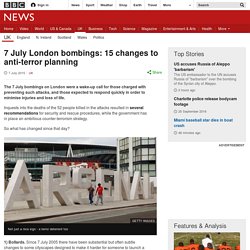
Inquests into the deaths of the 52 people killed in the attacks resulted in several recommendations for security and rescue procedures, while the government has in place an ambitious counter-terrorism strategy. So what has changed since that day? Image copyright Getty Images 1) Bollards. Since 7 July 2005 there have been substantial but often subtle changes to some cityscapes designed to make it harder for someone to launch a bomb attack. 2) Regional MI5. 3) Intelligence sharing. 4) Digital data gathering. Exactly what happened that day Who were the 52 dead victims? The victims who just walked away 5) Ambulance response. 6) Tube stations numbered. 7) Tube communications. 8) Police-like command structure. 9) Power down. 10) Staffing changes. 11) First aid kits. 12) Preparing for the worst. 14) Border protection.
7 July London bombings: What happened that day? Image copyright PA Ten years ago, four suicide bombers with rucksacks full of explosives attacked central London, killing 52 people and injuring hundreds more.

It was the worst single terrorist atrocity on British soil. 7 July 2005 London bombings. "7/7" redirects here.

For the calendar date, see July 7. The 7 July 2005 London bombings, sometimes referred to as 7/7, were a series of coordinated terrorist suicide bomb attacks in central London which targeted civilians using the public transport system during the rush hour. On the morning of Thursday, 7 July 2005, four Islamist extremists separately detonated three bombs in quick succession aboard London Underground trains across the city and, later, a fourth on a double-decker bus in Tavistock Square. Fifty-two people were killed and over 700 more were injured in the attacks, making it Britain's worst terrorist incident since the 1988 bombing of Pan Am Flight 103 over Lockerbie, Scotland, as well as the country's first ever Islamist suicide attack. The explosions were caused by homemade organic peroxide-based devices packed into backpacks. Attacks[edit] LONDON ATTACKS. Hasib Hussain. Hasib Mir Hussain (16 September 1986 – 7 July 2005) was one of four terrorists who detonated bombs on three trains on the London Underground and one bus in central London during the 7 July 2005 London bombings.
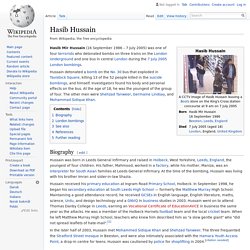
Hussain detonated a bomb on the No. 30 bus that exploded in Tavistock Square, killing 13 of the 52 people killed in the suicide bombings, and himself. Investigators found his body and personal effects on the bus. At the age of 18, he was the youngest of the group of four. The other men were Shehzad Tanweer, Germaine Lindsay, and Mohammad Sidique Khan. London Ambulance Service - London bombings in 2005. Shortly before 9am on 7 July 2005, we received calls to various locations in central London where there were reports of explosions on the Underground.

Bombs had exploded on three Underground trains at King’s Cross, Aldgate East and Edgware Road. These were followed by another bomb on a bus at Tavistock Square. What we did on the day During the next few hours, we worked with other blue-light services to rescue and treat casualties, and take them to various London hospitals.
We were supported by St John Ambulance, the Red Cross, and surrounding ambulance services. More than 250 members of our staff were involved in our emergency response. For a short period of time, while we were under immense pressure, we responded to life-threatening calls only. LONDON ATTACKS. The four men who carried out the 7 July bombings were young Britons who had led apparently ordinary lives.

Their profiles are below. Liverpool Street station. Liverpool Street, also known as London Liverpool Street,[4][5] is a central London railway terminus and connected London Underground station in the north-eastern corner of the City of London, in the ward of Bishopsgate.
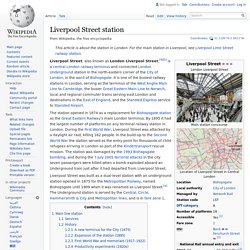
It is one of the busiest railway stations in London, serving as the terminus of the West Anglia Main Line to Cambridge, the busier Great Eastern Main Line to Norwich, local and regional commuter trains serving east London and destinations in the East of England, and the Stansted Express service to Stansted Airport. The station opened in 1874 as a replacement for Bishopsgate station as the Great Eastern Railway's main London terminus. By 1895 it had the largest number of platforms on any terminal railway station in London. During the First World War, Liverpool Street was attacked by a daylight air raid, killing 162 people.
Main line station[edit] Services[edit] The typical off-peak weekday service pattern from Liverpool Street is: History[edit] Underground station[edit] H. Edgware Road. The road[edit] Shoot-up Hill, one of several names for Edgware Road.
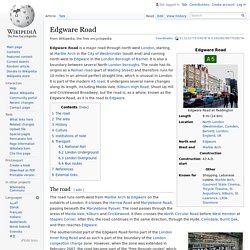
The southernmost part of the Edgware Road forms part of the London Inner Ring Road and as such is part of the boundary of the London congestion charge zone. However, when the zone was extended in February 2007, the road became part of the "free through routes" which allows vehicles to cross the zone during its hours of operation without paying the charge. The southern part of the road between Marble Arch and Maida Vale, noted for its distinct Middle Eastern cuisine and many late-night bars and shisha cafes, is known to Londoners by nicknames such as Little Cairo,[1][2] Little Beirut[3][dead link] and, especially near Camden, Little Cyprus.[4][5]
My Sister Lives on the Mantelpiece. My Sister Lives On The Mantelpiece is a 2011 novel written by Annabel Pitcher.
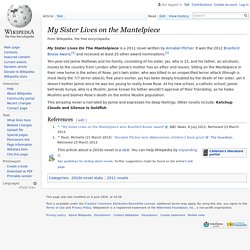
It won the 2012 Branford Boase Award,[1] and received at least 25 other award nominations.[2] Ten-year-old Jamie Mathews and his family, consisting of his sister, Jas, who is 15, and his father, an alcoholic, moves to the country from London after Jamie's mother has an affair and leaves. Sitting on the Mantelpiece in their new home is the ashes of Rose, Jas's twin sister, who was killed in an unspecified terror attack (though is most likely the 7/7 terror attack), five years earlier. Jas has been deeply troubled by the death of her sister, yet it doesn't bother Jamie since he was too young to really know Rose.
At his new school, a catholic school, Jamie befriends Sunya, who is a Muslim. This amazing novel is narrated by Jamie and expresses his deep feelings.